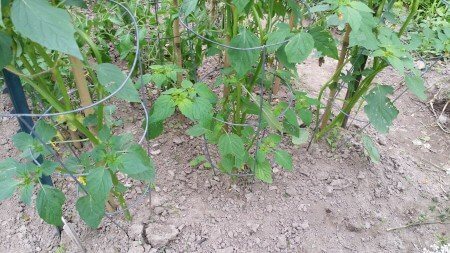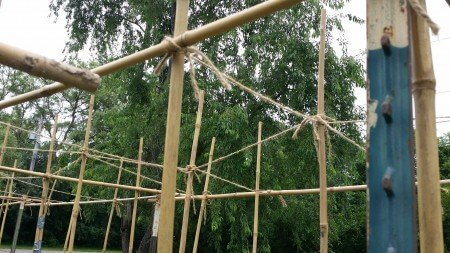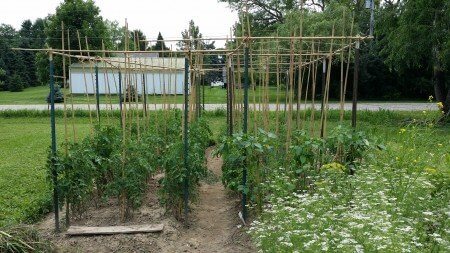I didn’t have the heart to cull out some of my beautiful and healthy tomato starts so I ended up with 78 plants in two beds. My normal planting is 60 plants in two beds so I had to cheat a little on the spacing. I opened up the width across the rows and pushed the plants as far to the edges of the bed as I thought I might get away with. I still came close to a 20″ spacing between plants and that’s close to what I always do.
I’d already determined that I was going to develop a trellis system using the eight foot bamboo stakes I bought last year. I wanted a structure with more rigidity and easier maintenance than previous trellises. I knew bamboo stakes would work. This is the result.
In this planting are three each of 24 different heirlooms or open pollinated varieties and one hybrid – Sungold, the excellent little orange cherry tomato that is usually the first and last tomato harvested each year. Also here (seen below) are three tomatillos, not quite a tomato, but pretty close. Their growing requirements are nearly the same.
I put tomato cages around my seedlings while they are still small and train the plants to stay inside the cages. Many gardeners don’t like traditional cages, but I find them useful in that they give me some time to get a more beefy structure set up. Plus I use the cages as a framework to tie everything back to the t-posts. This creates kind of a tension structure that is close to impervious to winds and the weight of heavy plants.
I have four t-posts on each side of the bed. The t-posts are 90 inches long overall with about 16” driven into the ground, so the structure frame is about six feet tall. I like using t-posts for trellising. They are rock solid once they are in the ground and they are easy to tie off to. I use a cheap jute twine for most of my trellising. It’s soft enough that it can be used on plant stems. And it’s biodegradable and rots away in a season in the compost pile so I don’t have a disposal problem as I would with a plastic tie.
I use one bamboo pole for each plant set next to the main stem and aligned with the t-posts. I tie the cages into each other and to the t-posts wherever I can.
All the outer bamboo gets tied off to a t-post or a lateral bamboo framing pole, so they have a lot of rigidity. The bamboo poles in the center are free standing, but laced into their adjacent poles. This should give the center poles enough stiffness (I hope) to handle the loading as the plants mature.
I’m training the plants to be as vertical as possible by loosely wrapping multiple stems around the bamboo using the jute twine. With very little help, tomatoes like to grow upwards.
I’m getting lots of air flow through the plants even though they are tightly spaced. I don’t mulch my tomatoes. When I tried mulching I had severe slug problems. I now try to keep the ground around the main stems weed free and dry. I prune away low hanging stems and leaves and try to get as much vertical growth as possible. It took me about a full day to set all this up, but I think I’m going to be very happy with the results.







I will be at the sheep and wool show sept 6th, I would like to see you tomatoe trellis.